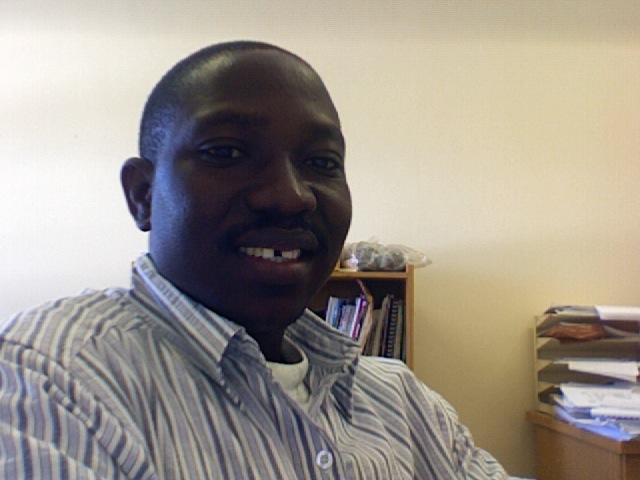
�PhD student: Chemical Engineering (University of Stellenbosch, Stellenbosch, South Africa/IRCELYON, France) July, 2007-present.
�M.Sc. Biotechnology (Process Technology Option) Wageningen University and Research Centre, Wageningen, The Netherlands. 2007.
�Certificate in Short course on Membrane Technology in Drinking
& Industrial Water Treatment UNESCO-IHE, Delft, The Netherlands. Sept. 2006.
�M.Sc. (Distinction) Chemical Engineering ,Obafemi Awolowo University, Ile-Ife, Nigeria. 2004.
�B.Sc. (Hons) Second Class (Upper Division) Chemical Engineering ,Obafemi Awolowo University, Ile-Ife, Nigeria. 1997.
Publications /Conferences/Symposia/Seminars:
�M.O. Daramola, S.R.A. Macaulay and A.I.Adedeji, 2006. Designing an algorithm for multi-component, multi-stage absorption column, Journal of Applied Science and Technology, 11(1&2): 52-56.
�M.O. Daramola. K.J.Keesman, and F. Spenkelink, 2007. Process modelling of Ultrafiltration Units: A RSM approach, Journal of Applied Sciences, 7(23): 3687-3695.
�M.O. Daramola,A. Zampraka, E.F. Aransiola and G.A.Adeogun. 2008. Numerical modelling and simulation of Liquid -impelled Loop Reactor , APPLIED SCIENCES vol. 10: 54-65.
�M.O. Daramola, A.J. Burger, A. Giroir-Fendler, S. Miachon. 2009. Nanocomposite MFI-alumina membranes: influence of operating parameters on xylene vapour mixture separation, accepted for oral presentation, 3rd International conference on Nanoscience and Nanotechnology (NanoAfrica2009)
�M.O. Daramola.2008.Modeling orifice diameter for optimal solvent droplet formation in Liquid-impelled loop reactor: a case study of tetralin extraction, European Journal of Scientific Research (EJSR) 23(3): 485-494.
�M.O. Daramola, A. Zampraka. 2008. Experimental study of the production of biomass by Saccharomyces Cerevisiae in a Fed-batch fermentor, African Journal of Biotechnology 7(8): 1107-1114.
�M.O. Daramola and Tim Grootschoten �A comparative study of non-parametric models for identification of Linear-Time-Invariant systems� in press
�M.O. Daramola, Keesman, K.J. 2008. Modeling and Economic analysis of ultrafiltration unit: case study of a full-scale plant European Journal of Scientific Research (EJSR) 20(3): 544-557
�OPCW Delegate, 6th International Conference on Process Intensification, 27-29 September 2005, Technical University (TUDelft), Delft, The Netherlands.
�Oladimeji, O.A. Adetunji, M.O. Daramola, E.F. Aransiola, B.O. Solomon, and M.O. Aremu (2005): �Comparative Study of Biodegradative Ability of Pseudomonas Species on Phenol and Total Organic Carbon of a Refinery Wastewater �International Engineering Conference 2005, University of Lagos, Nigeria.
�M.O. Daramola, (April, 2007) Process and Economic Modelling of Ultrafiltration Units: An RSM approach, Sensible Water TechnologySymposium, SENSE, The Netherlands.(www.sense.nl)
Professional Membership:
�COREN Registered Engineer (R. Eng)
�Member, Nigerian Society of Engineers (MNSE)
�Associate Member, Nigerian Society of Chemical Engineers (AMNSChE)
�Member, European Federation of Biotechnology (MEFB)
�Member, American Chemical Society (MACS)
�Member, American Institute of Chemical Engineers (MAIChE)
Current PhD Research:
Title: Characterization and Optimization of Catalytic Membrane Reactor (CMR) for Isomerization of m-xylene
Over the past decades, membrane processes have found broad application for a wide range of separations. When it comes to combination with reaction or conversion, membranes have mainly found application in a sequential mode. That is, reaction followed by separation. However, a membrane reactor integrates conversion and separation. In the past few years, several reviewed papers have emerged, usually covering parts of the success in the application of membrane reactor [Dixon, 1999; Saracco and Specchia, 1994; Saracco et al, 1999; Sirkar et al, 1999; Tsotsis et al, 1993]. The advantages of membrane reactors as compared to sequential reaction-separation systems include increase in reaction rate, reduction in by-product formation, lowering of energy requirement and possibility of heat integration. These advantages potentially lead to compact process equipment that can be operated with a high degree of flexibility. Because of the reduced by-product formation and the more efficient use of energy, the development of membrane reactor clearly fits into the scope of developing sustainable process for the future [Kemmere and Keurentjes, 2001]. Recently, research efforts have been channeled towards the use of MFI-zeolite membrane for separation of xylene mixture because of its low -energy consumption compared to convectional techniques [Flanders et al, 2000; Baertsch et al, 1996; Xomeritakis et al, 2001; Sakai et al, 2001]. Alshebani et al, in their work, proposed the use of hollow fiber zeolite membranes for gas separation because of their low cost and much higher surface /volume ratio than MFI-zeolite tubular membranes [Alshebani et al, 2007]. For these reasons, this research employs the use of hollow and tubular zeolite membranes to further get deeper insight into their behaviours in terms of thermal stability, permeability and permselectivity using xylene isomerization as a model reaction.
1. Listening to musics
2. Playing soccer
3. Watching movies
4. Travelling